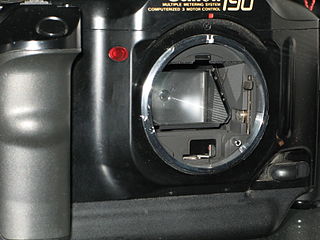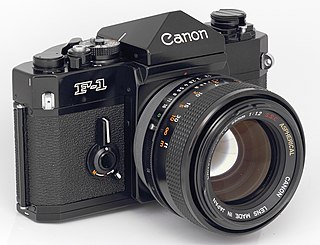
A camera lens is an optical lens or assembly of lenses used in conjunction with a camera body and mechanism to make images of objects either on photographic film or on other media capable of storing an image chemically or electronically.

The EF lens mount is the standard lens mount on the Canon EOS family of SLR film and digital cameras. EF stands for "Electro-Focus": automatic focusing on EF lenses is handled by a dedicated electric motor built into the lens. Mechanically, it is a bayonet-style mount, and all communication between camera and lens takes place through electrical contacts; there are no mechanical levers or plungers. The mount was first introduced in 1987.

The Canon FD lens mount is a physical standard for connecting a photographic lens to a 35mm single-lens reflex camera body. The standard was developed by Canon of Japan and was introduced in March 1971 with the Canon F-1 camera. It served as the Canon SLR interchangeable lens mounting system until the 1987 introduction of the Canon EOS series cameras, which use the newer EF lens mount. The FD mount lingered through the release of the 1990 Canon T60, the last camera introduced in the FD system, and the end of the Canon New F-1 product cycle in 1992.

A teleconverter is a secondary lens mounted between a camera and a photographic lens which enlarges the central part of an image obtained by the lens. For example, a 2× teleconverter for a 35 mm camera enlarges the central 12×18 mm part of an image to the size of 24×36 mm in the standard 35 mm film format.

The EF 1200mm f/5.6L USM is a super-telephoto prime lens that was made by Canon Inc. It uses an EF mount, and is compatible with the Canon EOS camera range. It has a focal length of 1200 mm and so on a digital body with a sensor size of 22.5 mm × 15 mm, such as a Canon EOS 40D or 450D, it provides a 35 mm field of view equivalent to that of a 1920 mm lens. With a body with a sensor size of 28.8 mm × 19.2 mm, such as a Canon EOS-1D Mark IV, the field of view is equivalent to that of a 1560 mm lens.

The EF 50mm lenses are a group of normal prime lenses made by Canon that share the same focal length. These lenses are based on the classic double-Gauss lens, with the f/1.8 being a standard six-element double-Gauss with an air gap and powers between element 2 and 3 and its faster cousins adding additional elements. The 50mm focal length, when used with a 35mm film or full-frame sensor, has been widely considered to match the perspective seen by the human eye.

The Canon EF is a manual focus 35mm single-lens reflex camera produced by Canon between 1973 and 1978. It was compatible with Canon's FD-mount lenses. The EF was built as an electro-mechanical version of Canon's top-of-the line wholly mechanical Canon F-1. The shutter is mechanical at all speeds starting at 1/2 second and faster, but from 1 second and beyond the shutter is all electric, allowing for AE shutter speeds as long as 30 seconds. The EF shares the F-1's rugged construction and tough metal body. Unlike the F-1, the EF does not support any motor drive for film transport. Neither does it provide any interchangeable viewfinder.

The Canon F-1 is a 35 mm single-lens reflex camera produced by Canon of Japan from March 1971 until the end of 1981, at which point it had been superseded by the New F-1 launched earlier that year. The Canon FD lens mount was introduced along with the F-1, but the previous Canon FL-mount lenses and older R- series lenses were also compatible with the camera with some limitations. The Canon F-1 was marketed as a competitor to the Nikon F and Nikon F2 single lens reflex cameras by Nikon.
The Canon FL 1200mm f/11 was a super-telephoto lens marketed by Japanese optical manufacturer Canon in June 1972. It was the longest super-telephoto lens in the Canon FL system.

The EF 85mm lenses are a group of medium telephoto prime lenses made by Canon Inc. that share the same focal length. These lenses have an EF type mount that fits the Canon EOS line of cameras.

Canon's series of L lenses are a professional line of photography lenses made by Canon. Canon has sold zoom and prime L-series lenses for the discontinued FD lens mount, for the current EF lens mount used on all Canon EOS SLR cameras and for the RF mount used on full-frame mirrorless interchangeable-lens cameras.

Eight designs of Canon FD 200 mm lens were produced for the Canon FD lens mount. These spanned two generations and varied by aperture and macro ability. These photographic lenses were:

The Canon EF-S 17–55mm f/2.8 IS USM is a standard zoom lens for Canon digital single-lens reflex cameras with an EF-S lens mount. The field of view has a 35 mm equivalent focal length of 27–88mm.

The EF 500mm lenses are a group of super-telephoto prime lenses made by Canon that share the same focal length.
The EF 70–300mm lenses are a series of telephoto zoom lenses made by Canon Inc. They have a Canon EF lens mount to work with the EOS line of cameras.

The Canon EF 22–55mmf/4–5.6 USM lens is a consumer grade lens that has now been discontinued. It was originally released in February 1998, as one of two kit lenses for the Canon EOS IX Lite, an APS-format film SLR, although it is also fully compatible with Canon's 35mm film SLRs, and subsequent APS-C and full-frame DSLRs.

The Canon EF 800 mm f/5.6L IS USM lens is a super-telephoto lens by Canon Inc., released at a manufacturer's suggested retail price of US$11,999.00 and now selling at an MSRP of $12,999.00.

The EF 35–350mm f/3.5–5.6L USM lens is a discontinued telephoto zoom lens manufactured by Canon.
The EF 200–400 mm f/4L IS USM Extender 1.4× is an EF mount super telephoto zoom lens produced by Canon. It is part of the professional L-series and functions with the Canon EOS line of cameras. The EF 200–400 mm lens features an ultrasonic motor, image stabilization and weather sealing. It is the first and only EF lens with a built-in extender.
The Canon EF 50-200mm f/3.5-4.5 is an EF mount normal-to-telephoto zoom lens. It is one of the first lenses in the Canon EF series.















